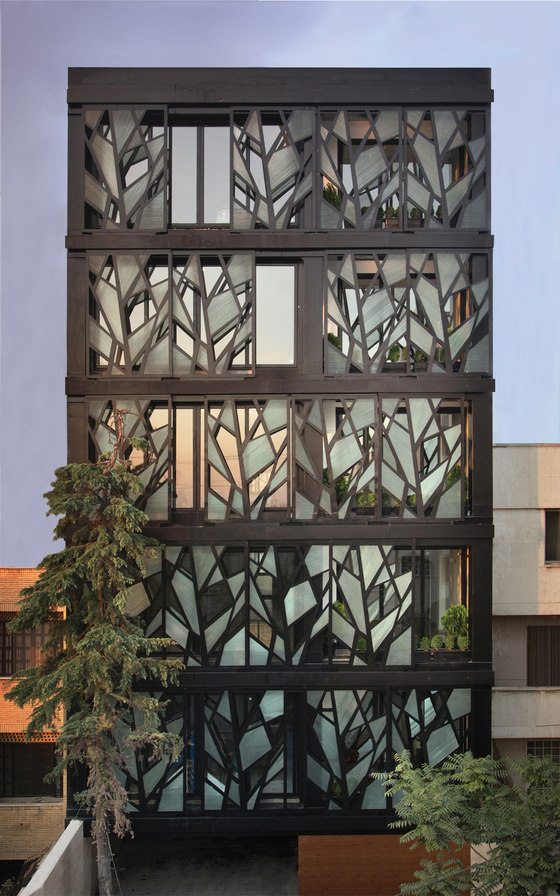Architecture Iran – innovative facades
Texte par Sophie Loschert
Berlin, Allemagne
23.11.15
The Western view of Iran has long been distorted. With the suspension of international sanctions, a spirit of optimism has taken hold of the country, including its architectural and design scene. In the first part of our new series ‘Architecture Iran’, we look at innovatively designed façades, whose dynamic compositions testify to a new self-confidence.
The facade elements of the Danial Apartment by TDC Office in a former recreational area in Tehran reflect the history of the site in a special way. The facade recalls the trees and plants that once grew here

The facade elements of the Danial Apartment by TDC Office in a former recreational area in Tehran reflect the history of the site in a special way. The facade recalls the trees and plants that once grew here
×Iran? Up until now, reporting on this Middle Eastern nation has focused to a large extent on its nuclear programme. In July, after 12 long years of negotiation, the E3+3 states and Iran reached an agreement lifting the existing sanctions in exchange for Iran limiting its nuclear programme to peaceful use.
Despite the sanctions and internal political restrictions, a lively and fascinating architectural scene has developed in recent years in the country between the Caspian Sea and the Persian Gulf. It has gone largely unnoticed up until now, but deserves a look.
Important trade routes crossed Persia in earlier centuries, exposing this land and its architecture to diverse outside influences. Beginning in the 1920s, Iranian architecture developed in a close relationship with European architecture. During the industrialisation of Iran under the rule of the Pahlavis, Western architects such as Kenzo Tange, Moshe Safdie, and Alison and Peter Smithson were commissioned to build factories, government buildings, and universities. The prevailing International Style, with its guiding principle ‘form follows function’, gained currency in Iran.
A cleft runs through the facade of the house by ReNa in Kermanshah, lending the building a sculptural quality and setting it clearly apart from its surroundings

A cleft runs through the facade of the house by ReNa in Kermanshah, lending the building a sculptural quality and setting it clearly apart from its surroundings
×Ornamental elements (calligraphy) and traditional materials better suited to regional climatic conditions (brick and tiles) made a comeback after the Islamic Revolution of 1979. Iran’s cultural, national, and religious values and ideals were to be reflected in the country’s architecture. At the same time, Western postmodernist and deconstructivist influences were also incorporated, leading to an eclectic mix of Western and traditional Persian forms, elements, and motifs.
Alongside this, a distinctly Iranian path emerged, one which combined inspiration from Persian culture with that from the West. A number of projects in recent years illustrate the conscious treatment of local tradition in combination with Western influences. Facades, in particular, offer unlimited design possibilities, as they provide protection from the outside gaze while permitting views outwards from the interior.
The shading elements in the Tehran office building by Boozhgan Architecture Studio create a dynamic facade while also controlling the entry of sunlight, without compromising the view of the nearby Elburz Mountains

The shading elements in the Tehran office building by Boozhgan Architecture Studio create a dynamic facade while also controlling the entry of sunlight, without compromising the view of the nearby Elburz Mountains
×Facade as sculpture
When Mandana Afsharian hired ReNa, a multidisciplinary architectural and design firm founded in 2012, to build a house for him and his family in Kermanshah, near the Iraqi border, he posed two requirements. First: the house was to feature clear forms, but also a facade design that would set it apart from its surroundings without appearing out of place. Second: the planning had to allow for the house’s possible later upward expansion.
The challenge for ReNa was thus to find a form whose elegance and attractive proportions would be preserved even after an addition to the house’s original three storeys. The designers ultimately decided on a rectangular volume with a cleft running through it, which lends the overall structure an almost sculptural quality. In a gesture of respect to passers-by – an important concept in Iranian culture – the lower part of the building is set back slightly.
A small pine wood near the building provided the inspiration for the 20 tree-like panels that move on two tracks like sliding doors. This produces special light and shading effects

A small pine wood near the building provided the inspiration for the 20 tree-like panels that move on two tracks like sliding doors. This produces special light and shading effects
×Facade as a second skin
Iran’s capital, Tehran, is located in the northern highlands and, with its 11 million inhabitants, is the country’s economic and cultural centre. Due to its sloping setting, there are substantial differences in elevation between the city’s various districts, with the urban quarters in the south lying at 1,000 metres and the northern suburbs at 1,700 metres above sea level.
The north of the metropolis, in particular, offers a spectacular view of the Elburz Mountains. Boozhgan Architecture Studio deftly integrated this vista into the design of the Asef office building, using shading elements of wood not only to create a dynamic facade, but also to control the penetration of direct sunlight into the interior, without limiting the view of the surrounding region.
Light and shade
Facade elements similarly create a special play of light and shade in the Danial Apartment, realised by TDC Office in 2015. The seven-storey structure set in a former recreational area of Tehran reflects the history of the location, in which buildings have replaced the trees and plants that grew here. A small pinewood near the site inspired the 20 tree-like panels on the facade – four on each of the upper floors. These can be moved on two tracks like sliding doors, resulting in a variety of possible combinations; as in nature, the pattern of leaves is sometimes more, sometimes less dense, yielding different textures and degrees of transparency.
With the pivoting, cantilevered wood-clad boxes, Nextoffice takes up the native Iranian concept of winter and summer spaces – depending on the weather, the boxes can be rotated open or shut

With the pivoting, cantilevered wood-clad boxes, Nextoffice takes up the native Iranian concept of winter and summer spaces – depending on the weather, the boxes can be rotated open or shut
×Dynamic facade
In the Sharifi-ha House, completed in 2013, the firm Nextoffice has carried the idea of a dynamic facade to extremes. Three wood-clad boxes that can be pivoted up to 90 degrees transform the facade from a two-dimensional surface into a variable three-dimensional arrangement of cube-like volumes.
The rotatable cantilevered spaces are a novel interpretation of traditional Iranian architectural typologies: the taabestan-neshin and zemestan-neshin, or summer and winter houses or rooms – the former characterised by transparency and expansive windows, the latter featuring only small openings to the outside. Likewise, these movable rooms in the Sharifi-ha House can be swivelled ‘shut’ against the cold Tehran winter and ‘open’ in warmer weather to serve as terraces.















